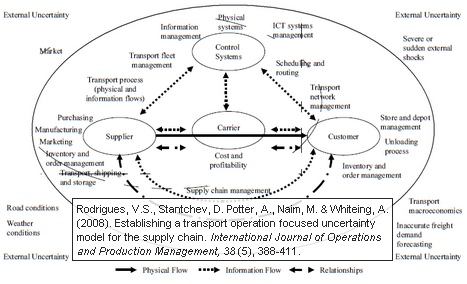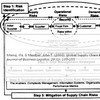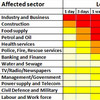 What a difference a title makes. I only found this article because it was referenced in another article. Why? Because it never occurred to me to search for articles on “risk” using “uncertainty” as a keyword. Bummer. Risk is undeniably linked to uncertainty, but I have never made that mental connection and never searched for articles on “supply chain risk” using the term “supply chain uncertainty”. Perhaps I should have, because Establishing a transport operation focused uncertainty model for the supply chain illustrates very well how transportation is a staple ingredient in supply chains and how uncertainty is a staple ingredient in risk assessments, and consequently, transportation uncertainty is a staple ingredient in supply chain risks.
What a difference a title makes. I only found this article because it was referenced in another article. Why? Because it never occurred to me to search for articles on “risk” using “uncertainty” as a keyword. Bummer. Risk is undeniably linked to uncertainty, but I have never made that mental connection and never searched for articles on “supply chain risk” using the term “supply chain uncertainty”. Perhaps I should have, because Establishing a transport operation focused uncertainty model for the supply chain illustrates very well how transportation is a staple ingredient in supply chains and how uncertainty is a staple ingredient in risk assessments, and consequently, transportation uncertainty is a staple ingredient in supply chain risks.
Hidden from clear sight
This is an article that truly hides its light under a bushel (at least as far as I am concerned), and it is an article that has pushed me a big leap forward in my own research efforts, because it links up perfectly with my own research on supply chain disruption risks in sparse transportation networks. Perhaps it’s just me, but I think journal articles should have succinct and clear titles and not obscure their true contribution … says he who proposed “ménage à trois” as a title yesterday.
Transportation: the key ingredient
Transportation is an often overlooked, but key factor in supply chains. No supply chain can function without transportation, and this article aims to
establish a supply chain uncertainty model that explicitly incorporates transport operations and hence the logistics triad; supplier, customer and transport carrier
So says the abstract, and much of the same is the core of my own research, where I focus on supply chain disruptions in freight transportation by road specifically. Our frameworks are indeed similar, yet distinctively different.
Three supply chain dyads
The foundation for the transportation-focused framework is found in Bask (2001), who developed a a model with three relationship triads that are in place in any supply chain with 3rd party logistics provider:

Bask refers to three sets of dyads, 1) buyer – seller, 2) seller – logistics provider, and 3) buyer – logistics provider. Bearing in mind yesterday’s discussion on triads in supply chains, I find it fair to say that this is better described as a triad rather than three dyads.
The supply chain triad
The authors then take Bask several steps forward, by adding elements of internal and external uncertainty, and by adding a control system that supervises the flows in the supply chain, including the carrier, aimed at achieving full supply chain visibility.

Transport-related uncertainties can occur in all five elements, for example:
- Uncertainties related to the supplier
- Poor management of outbound transports
- Uncertainties related to the customer
- Poor management of orders and inventory
- Uncertainties related to the carrier
- Delays and operational failures
- Uncertainties related to the control system
- Lack of updated and accurate data
- Uncertainties related to external circumstances
- Closures, fuel shortages, rules and regulations
The authors claim, and I will agree here, that
whilst many of the causes of uncertainty and their impacts can be linked primarily to one particular member of the logistics triad, in other cases the location of uncertainty depends on which triad member is responsible for planning, organising, procuring and managing the freight transport operation.
Transportation is obviously only one of many elements that can contribute to supply chain uncertainty, but is an element that ought not to be overlooked.
Conclusion
While this article does not look at transportation as a driving force behind supply chain uncertainties, it does point to the fact that transportation is a driving force behind supply chains. The authors do this by linking the traditional risk sources (or sources of uncertainty as they are termed here) and linking them to transportation-related events, events that are caused by transportation activities or events that in turn affect transportation activities, thus creating an element of uncertainty in the supply chain.
Reference
Sanchez-Rodrigues, V., Stantchev, D., Potter, A., Naim, M., & Whiteing, A. (2008). Establishing a transport operation focused uncertainty model for the supply chain. International Journal of Physical Distribution & Logistics Management, 38 (5), 388-411 DOI: 10.1108/09600030810882807
Bask, A. (2001). Relationships among TPL providers and members of supply chains – a strategic perspective. Journal of Business & Industrial Marketing, 16 (6), 470-486 DOI: 10.1108/EUM0000000006021
Author links
- cardiff.ac.uk: Vasco Sanchez-Rodrigues
- leeds.ac.uk: Damian Stantchev
- cardiff.ac.uk: Andrew Potter
- cardiff.ac.uk: Mohamed Naim
- leeds.ac.uk: Anthony Whiteing
Related post
- husdal.com: Uncertainty in Transportation and Logistics












